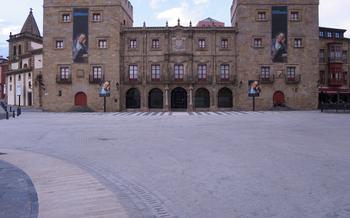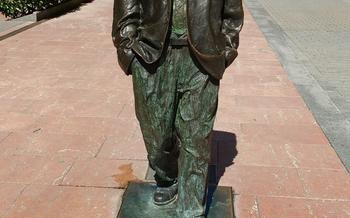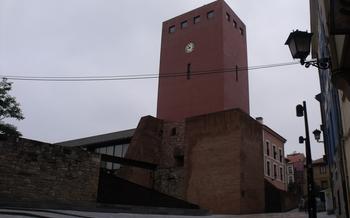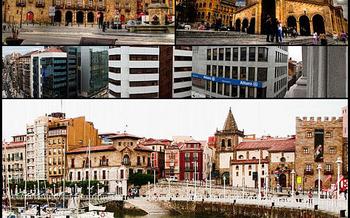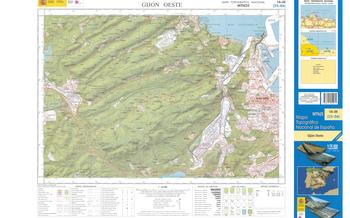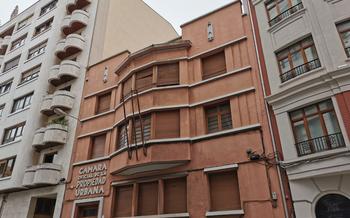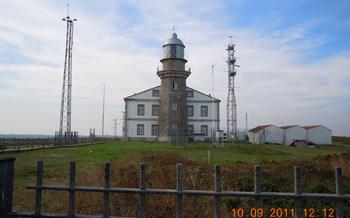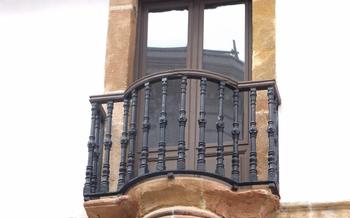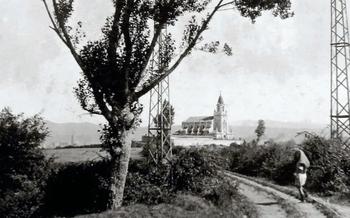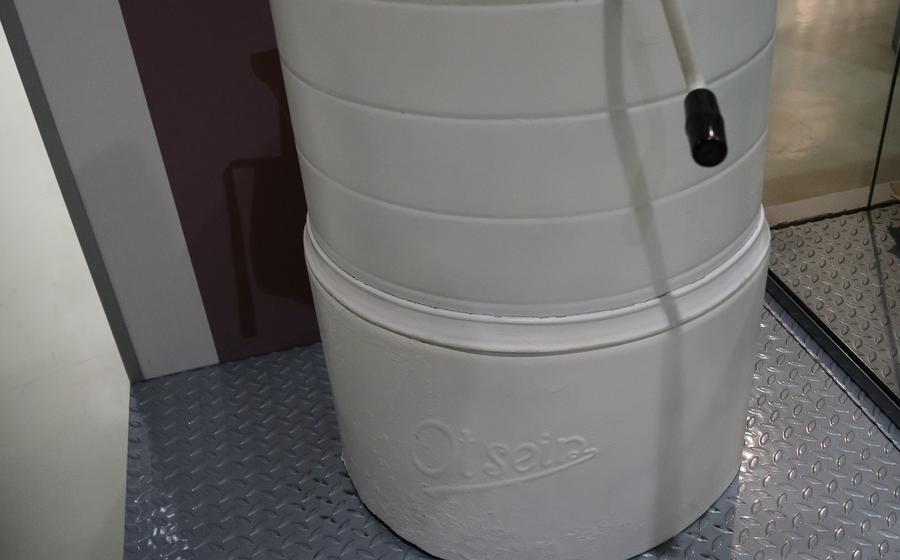
Museum of the Asturian People
- The Museum of the Asturian People: A Journey into Asturias' Past
- Permanent Exhibition: Unveiling Asturias' Cultural Heritage
- Temporary Exhibitions: Showcasing Contemporary Asturian Art and Culture
- Educational Programs: Engaging Visitors of All Ages
- Research Center: A Hub for Asturian Studies
- Events and Activities: A Vibrant Cultural Space
- Guided Tours: Exploring the Museum's Treasures with an Expert
- Accessibility: Ensuring an Inclusive Experience for All
- Museum Store: Mementos and Souvenirs to Cherish
- Hours of Operation and Admission Fees: Planning Your Visit
- Location and Getting There: A Convenient Destination
- Nearby Attractions and Points of Interest: Exploring Gijón's Cultural Treasures
- Local Cuisine: Savoring the Flavors of Asturias
- Insider Tip: Uncovering Hidden Gems
The Museum of the Asturian People: A Journey into Asturias' Past
Housed in a magnificent palace from the 18th century, the Museum of the Asturian People narrates the captivating story of Asturias' rich history, culture, and traditions. Established in 1968, the museum has become a repository of the region's heritage, preserving and showcasing its diverse facets through permanent and temporary exhibitions, research initiatives, and educational programs. Its strategic location in Gijón, a vibrant city on the Cantabrian coast, makes it easily accessible to visitors from around the world.
The museum's architectural grandeur mirrors the significance it holds for the region. Its elegant façade, adorned with intricate carvings and balconies, hints at the treasures that lie within. The palace's transformation into a museum has seamlessly integrated modern amenities while retaining its historical charm, creating a captivating ambiance for visitors to delve into the heart of Asturias' past.
Permanent Exhibition: Unveiling Asturias' Cultural Heritage
The permanent exhibition at the Museum of the Asturian People serves as a captivating journey through the rich cultural heritage of the region. It delves into various themes, including the origins of the Asturian people, their language and traditions, the region's unique natural environment, and its contributions to art, literature, and music.
Key artifacts on display include prehistoric tools, Roman mosaics, medieval manuscripts, and traditional Asturian costumes and crafts. Each item holds significant historical and cultural value, providing visitors with a deeper understanding of the region's past and its influence on its present-day identity.
Interactive displays and multimedia presentations complement the exhibits, bringing history to life and engaging visitors of all ages. Touchscreens, videos, and audio guides offer additional information, allowing visitors to explore topics in depth and personalize their museum experience.
The exhibition is thoughtfully laid out, with a logical flow that guides visitors through the different periods and aspects of Asturian history and culture. It begins with the region's earliest inhabitants and concludes with contemporary expressions of Asturian identity, providing a comprehensive overview of the region's rich and diverse heritage.
Temporary Exhibitions: Showcasing Contemporary Asturian Art and Culture
The Museum of the Asturian People is not just a repository of the past but also a vibrant platform for showcasing contemporary Asturian art and culture. Temporary exhibitions are held regularly, offering visitors a glimpse into the region's diverse and dynamic creative scene.
The frequency of these exhibitions varies, with some lasting for a few weeks and others running for several months. This allows the museum to present a wide range of topics and themes, from traditional crafts and folk art to cutting-edge contemporary installations.
Collaborations with local artists and institutions are a hallmark of the museum's temporary exhibition program. This ensures that the exhibitions are not only relevant to the local community but also of a high artistic caliber.
The impact of these exhibitions on the cultural scene of Gijón and Asturias is significant. They provide a platform for emerging artists to showcase their work, stimulate dialogue and debate, and contribute to the overall cultural vitality of the region.
Educational Programs: Engaging Visitors of All Ages
The Museum of the Asturian People is committed to fostering a deep appreciation for Asturian culture and heritage among visitors of all ages. To this end, the museum offers a diverse range of educational programs designed to engage and inspire.
Workshops, lectures, and guided tours are regularly organized to provide visitors with an immersive and interactive learning experience. These programs cover a wide spectrum of topics, from the history and traditions of Asturias to the significance of specific artifacts and artworks.
School groups are particularly encouraged to visit the museum, as the educational programs are tailored to meet the specific needs and interests of students. Interactive activities, hands-on exhibits, and guided tours help bring Asturian history and culture to life for young learners.
Families and individuals are also welcome to participate in the museum's educational offerings. Family-friendly workshops and activities provide a fun and engaging way for parents and children to learn together. The museum's knowledgeable staff is always on hand to answer questions and provide additional insights.
The success of the museum's educational programs is evident in the positive feedback received from participants. Many visitors have expressed their appreciation for the museum's efforts to promote cultural awareness and understanding.
One particularly memorable testimonial came from a group of students who visited the museum as part of a school trip. The students were particularly impressed by the interactive exhibits and the engaging manner in which the museum guides presented the information. They left the museum feeling inspired and eager to learn more about Asturian culture.
The Museum of the Asturian People is proud to play a vital role in educating and inspiring visitors of all ages. Through its educational programs, the museum is helping to ensure that the rich cultural heritage of Asturias continues to be valued and celebrated for generations to come.
Research Center: A Hub for Asturian Studies
The Museum of the Asturian People houses a renowned research center dedicated to preserving and studying the region's rich history and culture. This center serves as a hub for scholars, researchers, and students from around the world who are passionate about Asturian studies.
The research center boasts an extensive collection of books, manuscripts, documents, and artifacts related to Asturias, making it an invaluable resource for those seeking to delve deeper into the region's past. In addition to its impressive collection, the center collaborates with universities and research institutions, fostering a vibrant intellectual community that contributes to the advancement of knowledge about Asturias.
The center regularly organizes publications, conferences, and seminars to disseminate research findings, promote cultural exchange, and encourage interdisciplinary dialogue. These events provide a platform for researchers to share their work, exchange ideas, and engage with the broader community.
Through its research initiatives, the center plays a crucial role in preserving and promoting Asturian heritage, ensuring that the region's unique identity and traditions continue to thrive for generations to come.
Events and Activities: A Vibrant Cultural Space
The Museum of the Asturian People is not just a repository of artifacts; it is a vibrant cultural space that hosts a variety of events and activities throughout the year. From concerts and film screenings to theater performances and cultural fairs, there is always something happening at the museum. These events provide a platform for local artists and performers to showcase their work, while also offering visitors a chance to experience the diverse cultural traditions of Asturias. The museum collaborates with local cultural organizations to curate a program that appeals to a wide range of interests, ensuring that there is something for everyone to enjoy. Whether you are passionate about music, theater, or art, you are sure to find something to capture your imagination at the Museum of the Asturian People.
Insider Tip: Check the museum's website or social media pages for upcoming events and activities. Some events may require advance booking, so it is advisable to plan ahead to avoid disappointment.
Guided Tours: Exploring the Museum's Treasures with an Expert
To fully appreciate the rich tapestry of Asturian history and culture showcased at the Museum of the Asturian People, consider embarking on a guided tour. Led by knowledgeable and passionate experts, these tours offer an immersive experience that brings the exhibits to life.
Available in multiple languages, the guided tours provide insightful commentary and anecdotes that delve into the historical, cultural, and artistic significance of the artifacts on display. The guides are skilled at tailoring the tours to specific interests and groups, ensuring that every visitor gains a deeper understanding of Asturias' heritage.
Advance booking is recommended to secure your spot on a guided tour, especially during peak tourist season. Group discounts are also available, making it an ideal option for families, friends, or educational groups.
With a guided tour, you'll gain a deeper appreciation for the Museum of the Asturian People's treasures, leaving you with lasting memories of your visit to this cultural gem.
Accessibility: Ensuring an Inclusive Experience for All
The Museum of the Asturian People is committed to providing an inclusive and accessible experience for all visitors. The museum is fully wheelchair accessible, with ramps and elevators throughout the building. Audio guides and visual aids are available for visitors with disabilities, and Braille signage and tactile exhibits are provided for the visually impaired. The museum staff is trained to assist visitors with special needs, and they are always happy to answer any questions or provide assistance. The museum's website also provides information on accessibility features and services.
Museum Store: Mementos and Souvenirs to Cherish
The Museum of the Asturian People houses a well-stocked museum store where visitors can purchase a variety of mementos and souvenirs to cherish their visit and take a piece of Asturias home with them. The store offers a carefully curated selection of items inspired by the museum's collection and Asturian culture.
From traditional handicrafts and locally made pottery to replicas of historical artifacts and contemporary art pieces, there is something for everyone to find. Visitors can choose from a range of museum-themed merchandise, including postcards, posters, books, and educational materials.
Proceeds from the museum store directly support the museum's educational and research initiatives, ensuring that future generations can continue to learn about and appreciate Asturian history and culture. By purchasing a souvenir, visitors not only take home a tangible reminder of their experience but also contribute to the preservation and promotion of Asturias' rich heritage.
Among the unique gifts and souvenirs available, visitors can find limited-edition items and exclusive collaborations with local artisans. These special pieces offer a unique opportunity to own a one-of-a-kind memento of their visit to the Museum of the Asturian People.
Hours of Operation and Admission Fees: Planning Your Visit
Planning your visit to the Museum of the Asturian People is crucial to ensure a smooth and enjoyable experience. The museum's hours of operation are typically from Tuesday to Sunday, with varying opening and closing times depending on the season. It is advisable to check the museum's official website or contact them directly to confirm the exact hours during your intended visit.
Regular admission fees apply to adults, while discounted rates are offered to students, seniors, and groups. Children under a certain age may be eligible for free admission. Keep an eye out for special events or promotions where admission may be waived or reduced.
Online ticket booking is available for advance purchase of tickets, which is recommended during peak tourist seasons or if you prefer to avoid queues. Reservations can be made through the museum's website or authorized ticketing platforms.
Remember to take advantage of free admission days, which are usually offered on specific days of the week or during special events. These days vary, so checking the museum's calendar or website is essential.
With proper planning, you can optimize your visit to the Museum of the Asturian People, ensuring you have ample time to explore its treasures and immerse yourself in the rich cultural heritage of Asturias.
Location and Getting There: A Convenient Destination
The Museum of the Asturian People enjoys a prime location in the heart of Gijón, a vibrant coastal city in northern Spain. Its exact address is Calle de los Moros 6, placing it within easy reach of other cultural attractions, shopping areas, and transportation hubs.
Getting to the museum is a breeze, with multiple public transportation options available. The Gijón bus network provides several routes that stop near the museum, and the RENFE train station is just a short walk away. For those arriving by car, there are several parking garages and street parking options within a short distance.
For those who prefer active transportation, the museum is easily accessible by foot or by bike. The city center is relatively flat, making it a pleasant walk to the museum from many hotels and attractions. There are also designated bike lanes and bike-sharing stations throughout the city, allowing visitors to explore Gijón on two wheels.
To ensure a smooth journey, here are the GPS coordinates for the museum: 4544080, -66866Simply plug these coordinates into your navigation system or smartphone maps app, and you'll be guided directly to the museum's doorstep.
Nearby Attractions and Points of Interest: Exploring Gijón's Cultural Treasures
Situated in the heart of Gijón, the Museum of the Asturian People is surrounded by a wealth of cultural attractions that offer a comprehensive journey through the city's rich heritage. Just a short walk away, the Archaeological Museum of Asturias houses an impressive collection of artifacts from the region's prehistoric and Roman past, shedding light on the earliest civilizations that shaped the Asturian identity.
For those interested in maritime history, the Maritime Museum of Asturias provides an immersive experience into the region's seafaring traditions. Visitors can explore exhibits on shipbuilding, fishing, and navigation, gaining insights into the vital role the sea has played in shaping Gijón's economy and culture.
Art enthusiasts will delight in the Museum of Fine Arts of Asturias, which showcases a diverse collection of paintings, sculptures, and decorative arts from the Middle Ages to the present day. The museum's holdings include works by renowned Spanish artists such as El Greco, Goya, and Picasso, as well as a significant collection of contemporary Asturian art.
Beyond museums, Gijón boasts a vibrant cultural scene with numerous theaters, music venues, and art galleries. The Jovellanos Theater, a beautifully preserved 19th-century playhouse, hosts a variety of performances, including plays, concerts, and dance productions. The Gijón International Film Festival, held annually, attracts filmmakers and moviegoers from around the world, showcasing a diverse range of independent films and documentaries.
For those seeking a unique cultural experience, the Cimadevilla neighborhood, located adjacent to the Museum of the Asturian People, offers a glimpse into Gijón's medieval past. This charming district, with its narrow cobblestone streets and traditional Asturian architecture, is home to numerous historical landmarks, art galleries, and boutiques, creating a vibrant tapestry of culture and history.
Whether you're interested in art, history, or contemporary culture, Gijón has something to offer every visitor. By combining a visit to the Museum of the Asturian People with these nearby attractions, you can immerse yourself in the city's rich cultural heritage and gain a deeper understanding of its unique identity.
Local Cuisine: Savoring the Flavors of Asturias
A trip to the Museum of the Asturian People is not complete without indulging in the region's rich culinary traditions. Gijón and its surroundings offer a delectable array of local dishes and specialties that showcase the bounty of Asturian cuisine.
For a truly authentic experience, head to one of the many sidrerías, traditional Asturian cider houses, that line the streets of Gijón. These lively establishments serve freshly poured cider, accompanied by a selection of local tapas and dishes. Don't miss the opportunity to try cachopo, a breaded and fried veal steak filled with cheese and ham, or fabada asturiana, a hearty bean stew with chorizo, morcilla, and pork.
If you prefer a more refined dining experience, Gijón boasts several Michelin-starred restaurants that reinterpret Asturian cuisine with innovative flair. Sample dishes like sea urchin ravioli with cauliflower cream or lobster with apple and curry sauce, all paired with carefully selected Asturian wines.
Vegetarians and those with dietary restrictions will find plenty of options in Gijón. Many restaurants offer meatless versions of traditional dishes, such as fabada asturiana made with vegetables instead of meat. Fresh seafood is also abundant, with dishes like grilled octopus or sea bass in green sauce being local favorites.
To fully immerse yourself in the local food culture, visit one of the many markets in Gijón. The Mercado del Sur, in particular, is a vibrant hub of activity where you can browse stalls selling fresh produce, seafood, and local specialties. Here, you can pick up ingredients to prepare your own Asturian feast or simply sample the delicious street food on offer.
When it comes to beverages, Asturias is known for its cider, a slightly sparkling, slightly tart drink made from local apples. Sidrerías are the best places to experience the traditional pouring ritual, where the cider is poured from a great height into a glass held low, creating a frothy head.
Whether you prefer hearty traditional fare or innovative culinary creations, Gijón offers a gastronomic journey that will delight your palate and leave you craving more.
Insider Tip: Uncovering Hidden Gems
Beyond the main exhibition halls, the Museum of the Asturian People holds hidden gems waiting to be discovered by curious visitors. One such gem is the "Secret Room," which showcases a collection of rare and unusual artifacts that have been tucked away for preservation. From ancient tools and weapons to peculiar objects with mysterious origins, this room offers a glimpse into the lesser-known aspects of Asturian history and culture.
Special events and exhibitions are also organized throughout the year, providing a platform for local artists and performers to showcase their work. These events often feature unique collaborations, experimental installations, and interactive experiences that push the boundaries of traditional museum exhibitions. Visitors can check the museum's website or inquire at the information desk for upcoming events and special programming.
For those seeking a deeper dive into Asturian culture, guided tours can be customized to explore specific interests and themes. Whether you're fascinated by traditional crafts, maritime history, or contemporary art, the museum's knowledgeable guides can tailor the tour to your preferences, offering insights and anecdotes that bring the exhibits to life. Advance booking is recommended for customized tours, especially for groups or those with specific interests.
